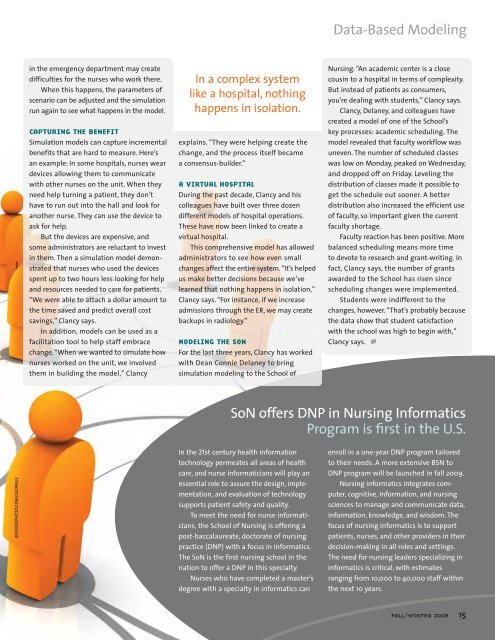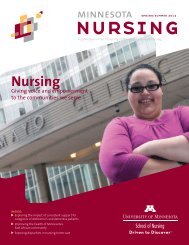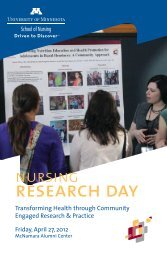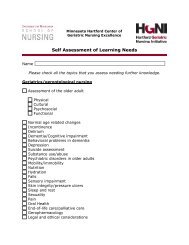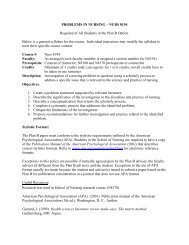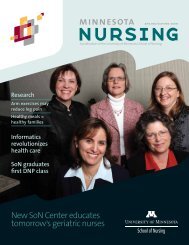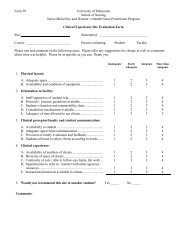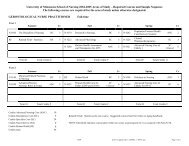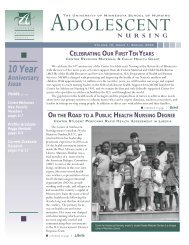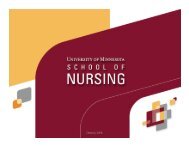CHANGING FACE of NURSING - School of Nursing - University of ...
CHANGING FACE of NURSING - School of Nursing - University of ...
CHANGING FACE of NURSING - School of Nursing - University of ...
You also want an ePaper? Increase the reach of your titles
YUMPU automatically turns print PDFs into web optimized ePapers that Google loves.
Data-Based Modeling<br />
in the emergency department may create<br />
difficulties for the nurses who work there.<br />
When this happens, the parameters <strong>of</strong><br />
scenario can be adjusted and the simulation<br />
run again to see what happens in the model.<br />
CAPTURING THE BENEFIT<br />
Simulation models can capture incremental<br />
benefits that are hard to measure. Here’s<br />
an example: In some hospitals, nurses wear<br />
devices allowing them to communicate<br />
with other nurses on the unit. When they<br />
need help turning a patient, they don’t<br />
have to run out into the hall and look for<br />
another nurse. They can use the device to<br />
ask for help.<br />
But the devices are expensive, and<br />
some administrators are reluctant to invest<br />
in them. Then a simulation model demonstrated<br />
that nurses who used the devices<br />
spent up to two hours less looking for help<br />
and resources needed to care for patients.<br />
“We were able to attach a dollar amount to<br />
the time saved and predict overall cost<br />
savings,” Clancy says.<br />
In addition, models can be used as a<br />
facilitation tool to help staff embrace<br />
change. “When we wanted to simulate how<br />
nurses worked on the unit, we involved<br />
them in building the model,” Clancy<br />
In a complex system<br />
like a hospital, nothing<br />
happens in isolation.<br />
explains. “They were helping create the<br />
change, and the process itself became<br />
a consensus-builder.”<br />
A VIRTUAL HOSPITAL<br />
During the past decade, Clancy and his<br />
colleagues have built over three dozen<br />
different models <strong>of</strong> hospital operations.<br />
These have now been linked to create a<br />
virtual hospital.<br />
This comprehensive model has allowed<br />
administrators to see how even small<br />
changes affect the entire system. “It’s helped<br />
us make better decisions because we’ve<br />
learned that nothing happens in isolation,”<br />
Clancy says. “For instance, if we increase<br />
admissions through the ER, we may create<br />
backups in radiology.”<br />
MODELING THE SON<br />
For the last three years, Clancy has worked<br />
with Dean Connie Delaney to bring<br />
simulation modeling to the <strong>School</strong> <strong>of</strong><br />
<strong>Nursing</strong>. “An academic center is a close<br />
cousin to a hospital in terms <strong>of</strong> complexity.<br />
But instead <strong>of</strong> patients as consumers,<br />
you’re dealing with students,” Clancy says.<br />
Clancy, Delaney, and colleagues have<br />
created a model <strong>of</strong> one <strong>of</strong> the <strong>School</strong>’s<br />
key processes: academic scheduling. The<br />
model revealed that faculty workflow was<br />
uneven. The number <strong>of</strong> scheduled classes<br />
was low on Monday, peaked on Wednesday,<br />
and dropped <strong>of</strong>f on Friday. Leveling the<br />
distribution <strong>of</strong> classes made it possible to<br />
get the schedule out sooner. A better<br />
distribution also increased the efficient use<br />
<strong>of</strong> faculty, so important given the current<br />
faculty shortage.<br />
Faculty reaction has been positive. More<br />
balanced scheduling means more time<br />
to devote to research and grant-writing. In<br />
fact, Clancy says, the number <strong>of</strong> grants<br />
awarded to the <strong>School</strong> has risen since<br />
scheduling changes were implemented.<br />
Students were indifferent to the<br />
changes, however. “That’s probably because<br />
the data show that student satisfaction<br />
with the school was high to begin with,”<br />
Clancy says.<br />
SoN <strong>of</strong>fers DNP in <strong>Nursing</strong> Informatics<br />
Program is first in the U.S.<br />
©ISTOCKPHOTO.COM/GEOPAUL<br />
In the 21st century health information<br />
technology permeates all areas <strong>of</strong> health<br />
care, and nurse informaticians will play an<br />
essential role to assure the design, implementation,<br />
and evaluation <strong>of</strong> technology<br />
supports patient safety and quality.<br />
To meet the need for nurse informaticians,<br />
the <strong>School</strong> <strong>of</strong> <strong>Nursing</strong> is <strong>of</strong>fering a<br />
post-baccalaureate, doctorate <strong>of</strong> nursing<br />
practice (DNP) with a focus in informatics.<br />
The SoN is the first nursing school in the<br />
nation to <strong>of</strong>fer a DNP in this specialty.<br />
Nurses who have completed a master’s<br />
degree with a specialty in informatics can<br />
enroll in a one-year DNP program tailored<br />
to their needs. A more extensive BSN to<br />
DNP program will be launched in fall 2009.<br />
<strong>Nursing</strong> informatics integrates computer,<br />
cognitive, information, and nursing<br />
sciences to manage and communicate data,<br />
information, knowledge, and wisdom. The<br />
focus <strong>of</strong> nursing informatics is to support<br />
patients, nurses, and other providers in their<br />
decision-making in all roles and settings.<br />
The need for nursing leaders specializing in<br />
informatics is critical, with estimates<br />
ranging from 10,000 to 40,000 staff within<br />
the next 10 years.<br />
fall/winter 2008<br />
15


